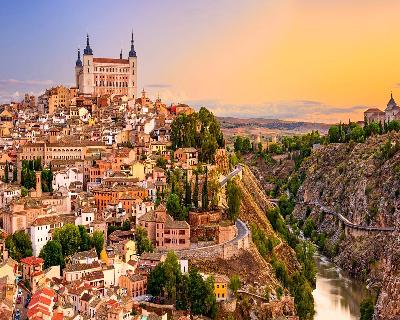
Ciudad Real is the renowned historical capital of the Autonomous Community of Castilla-La Mancha, it is part of the Campo de Calatrava region and is the center of the Ciudad Real province. The city is located at a distance of 180 km from the Spanish capital, Madrid. The city has 75,000 inhabitants. There is an airport and a railway line. All this, together with its historical heritage, contributes to the dynamic development of the city.
The foundation of the city dates back to the 13th century under the reign of king Alfonso X . The city was built as a fortification system, whose fortress walls were about 4 km long and had 130 towers. Thanks to the strong walls, the population living on the territory of the city was reliably protected from external invasions. In 1691, Ciudad Real became the capital of the old province of La Mancha, which contributes to the serious development of the city and the construction of magnificent buildings. In 1755, a powerful earthquake severely destroyed many buildings. And during the Napoleonic wars the city was devastated. In the 20th century, during the Civil War, the city was a powerful seat of resistance to the Franco regime and surrendered just two days before the end of the war.
Today, Ciudad Real is a modern capital surrounded by picturesque national parks. In addition, travelers are attracted to visit these picturesque places, the desire to follow the paths of the hero of the book Don Quixote, who travels through the province of La Mancha, coming from under the pen of Cervantes.
St. Peter's Church:
The Church of San Pedro, founded in the 14th century by three knights. It was built in the Gothic style and is more akin to a fortress than a Christian temple.
Virgin Mary Cathedral:
The Cathedral of the Virgin Mary, which is called the most beautiful building in the city. It has features of the Baroque, Renaissance and Gothic style that the Spanish adore.
Toledo Gate:
Puerta de Toledo is one of the few surviving parts of the city wall that was once considered indestructible. Castilla's stone shield can still be seen on the wall.
Don Quixote Museum:
The Don Quixote Museum. Here you will see a collection of paintings and engravings representing the beloved hero, a luxurious library and other exhibits.
Main Square:
It is part of the central square of the city. Tourists especially like the bells installed in it, from which Don Quixote emerges with his faithful squire Sancho Pance, as well as Cervantes himself.
Cabaneros Park Visitors Center:
The Cabaneros Park Visitors Center is located in Horcajo de los Montes.
